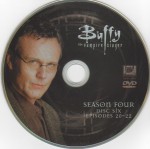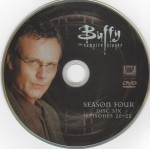With the season’s big bad disposed of in the penultimate episode and only a thin thread connecting four surreal dream sequences, Buffy the Vampire Slayer’s season four finale, ‘Restless,’ is arguably the most unconventional episode of the whole series. Based on his comment on the DVD audio track that he “wanted to do a commentary on [this episode] because it’s different than anything else [he] had ever done before or have ever done since,” it seems Joss Whedon would agree (00:00:15).
(Spoiler alert)
Unlike the real thing, dream sequences in films or TV shows do not occur by chance. Departing from typical season finale expectations was a very deliberate decision on Whedon’s part. The episode picks up immediately after the previous episode’s big climax as Buffy and the Scoobies curl up on the couch at her mom’s place with a bowl of popcorn and a stack of movies…and promptly fall asleep. Whedon explains why he chose to approach the season finale this way as follows: “The big two-part climax took place this year, unlike the years before, in episodes 20 and 21, and a lot of people commented on that. They didn’t understand why we didn’t finish with the big-wow explosion finish, but because we had done that twice in a row we really felt like it would be nice to do something very very different” (00:01:10). I seem to remember season one also ended with a bang, so I’d be curious to know why he doesn’t say they’d done it thrice in a row; for now, I’ll assume it’s because budgetary constraints on the first season muffled the bang.
TV shows rarely, if ever, show the mundane aftermath of a big conflict, so it’s interesting, and rather funny, to see them all quickly shift down from high-octane evil-fighting excitement to a low-key evening at home. Now that I think about it, the opening of the episode is very similar to the post-credits scene in The Avengers, with the superheroes completely zoned out as they chow down in a ruined shwarma shack. That scene was a hit with fans, but it probably lasted less than 30 seconds. If The Avengers: Age of Ultron focuses entirely on their dreams during a shwarma-induced nap, I’m pretty sure the reaction would be a bit different. Even back in 2000, when Whedon might have known less (but still lots) about his craft and had more (but worse) hair, he knew some people wouldn’t like what he was trying to do. “I knew that a lot of people would be alienated by it, and not get it, or not want it if they did get it,” he says, “But to me it was a great exercise—as great an exercise as [the episode] ‘Hush’—in learning about how to write and what it means” (00:03:25).
Since Whedon had accepted that from the start, he was able to embrace the risk involved with learning something new about writing. In this case, he had to take a very different approach to the craft. As he explains,
This was, for me, a great big departure, because everything I’ve done has been very very carefully structured. Every story, every beat of every story, is structured before I write a word. I can’t write unless I know exactly where I’m going, and although I did have a general idea of where I was going…in this particular instance I couldn’t know where I was going. I literally had to just let it flow, and make sure the images were true to the characters, true to the flow of the energy of the narrative so that there was some momentum—things become creepier as we go along—but basically I just had to free-associate in every act, which for me was very liberating. (00:02:25)
Listening to Whedon, it also seems that the process reinvigorated him in the same way writing and directing the largely wordless episode ‘Hush’ did—it challenged him to learn something new about himself and storytelling, which he then plugged back into the show.
From my perspective as a fan who didn’t love (but didn’t hate) the episode, I’d say anything that keeps the show and it’s creator fresh and true to form, while still advancing the story, is well worth it.
Although Whedon had to shed the structure of his usual process while writing this episode, the story he wrote found its structure in the dreams of Willow, Xander, Giles, and Buffy. “One dream per act…and the running thread in all of them being that they would be attacked by the spirit of the first slayer, The Primitive, who would be sort of killing them in their dreams one by one until Buffy had the sort of strength and spirit to make her go away, much like Freddy Krueger in the first [Nightmare on Elm Street] now that I think of it” (00:01:45).
Speaking of connections to other movies, this episode is loaded with them. Obviously there are multiple nods to Apocalypse Now throughout the episode, but there are also stylistic cues taken from Steven Soderbergh’s The Limey (00:14:15), Stanley Kubrick’s Eyes Wide Shut (00:24:45), and Orson Welles’ adaptation of Franz Kafka’s The Trial (00:34:00). Most of them involve camera angles, framing and movements, editing, and colour palettes; since they’re hard to appreciate without watching the specific shot, I’ll leave it to those who are interested to track down a copy of season four, disc six, and check out the above time codes in episode 22 for themselves.
I’ll end it here for now. Next time we’ll get into Joss Whedon’s interpretation of some of these dreams and what Buffy learns, and reveal the coded references to season five and the Dawn’s forthcoming appearance. We’ll also get the answer to the most-asked question of all time EVER (it could be true): “What’s the significance of the Cheese Man?”
Don’t forget to check out my Twitter account, @GregOsadec, where I post mini-movie reviews, film- and horror-related links, and other amazingly miscellaneous items throughout the week.
Buffy the Vampire Slayer, Season 4, Episode 22, ‘Restless’ | Written & Directed by Joss Whedon | Starring Sarah Michelle Gellar, Alyson Hannigan, Nicholas Brendon, Anthony Stewart Head
Want to know more?
– Here’s a detailed episode summary from the good folks at IGN
– Here’s a review of ‘Restless’, as well as the couple of episodes leading up to it, as well as some random observations from the episode, AND a sort of reflection on the first season of Angel. That covers a lot of bases…and maybe some of the outfield, too.
What do you think? Was this episode a success? Have you noticed any other connections between it and Whedon’s other work? Would you like to see other shows take risks like this with their season finale? Can you think of other shows that have attempted something similar? Leave some comments below and let us know!


PS, for the “Want to Know More” section.
To check out an amazing, masterfully crafted review, go to Critically Touched:
http://www.criticallytouched.com/buffy/4x22_restless.php
Be warned, it’s about 12,000 words, and then there are several more lengthy dissections in the comments which are super-interesting. The first time I stumbled onto it, I cried.
LikeLike